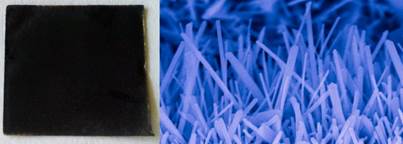Facile Solution Synthesis and Photoelectric Properties of Monolithic Tin(II) Sulfide Nanobelt Arrays
Xing Zhang, Long Yang, Yan Jiang, Bin-Bin Yu, Yu-Gang Zou, Ying Fang, Jin-Song Hu, Li-Jun Wan
Chem.- Asian J., 2013, 8, 2483–2488, DOI: 10.1002/asia.201300626
http://onlinelibrary.wiley.com/doi/10.1002/asia.201300626/abstract
Abstract (click image for pdf file)
The tremendous future energy demand and environmental concerns prompt the lasting search for new materials for low-cost and high-efficiency solar cells. SnS, as a low-cost, earth-abundant, and environmentally friendly material with proper band gap and absorption coefficient, has received attention as a potential candidate for solar absorber, but it is still under-developed due to insufficient conversion efficiency. Fabricating SnS nanostructured films for solar cell design could be effective to boost photovoltaic performance and pave the way for applications in photovoltaics. Herein, a facile surfactant-free solution-based approach has been developed to prepare monolithic SnS nanostructured films directly on tin foil substrate. The morphologies of nanostructured films could be tuned from well-defined orthorhombic SnS nanobelt arrays to nanorods, nanosheets, or nanoflakes by simply changing the ratio of used solvents. The photoelectric response and electronic transportation properties of SnS nanobelts were investigated by fabricating single-nanobelt-based nanodevices. The SnS nanobelt exhibited a fast and reliable photoresponse even at illumination intensity as weak as 0.103 mW cm−2. The measurements on SnS FET devices also indicated that the synthesized SnS nanobelts demonstrated a hole mobility as high as 12.33 cm2 V−1 s−1. These results reveal that the reported approach for preparing monolithic SnS nanostructured films could be useful to further develop SnS as an alternative material for low-cost solar cells and electronic devices.


